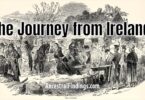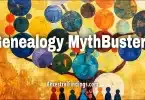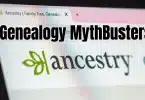If you’ve been researching family history for any length of time, you’ve probably heard someone say, “Well, the trail stops with the immigrant ancestor. Once you hit the ocean, you can’t go any further.” This idea is one of the most persistent myths in genealogy. Many people stop at the ancestor who stepped off the ship, resigned to the belief that records from “the old country” are too hard to find, inaccessible, or simply don’t exist.
At first glance, the myth makes sense. Immigration records can be patchy. Language barriers are intimidating. Foreign archives may seem distant and mysterious. For years, genealogists accepted the idea that you could trace your family back to the arrival in America, Canada, or Australia, and no further.
But here’s the truth: genealogy doesn’t end at the ocean. The ocean is not a wall — it’s a bridge. With patience, persistence, and the right tools, you can cross it. Today, countless records from Europe, Africa, Asia, and South America are available in digital form. Archives are more accessible than ever. And local experts around the world are helping researchers trace their families across borders.
Why the Myth Exists
This myth grew out of genuine obstacles. In the 19th and early 20th centuries, immigrant descendants in North America or Australia had little practical way to access records overseas. Even if they knew the town their ancestor came from, traveling to Europe or Asia was expensive and time-consuming. Many records weren’t indexed, and archivists often guarded access closely.
Language was another barrier. If your great-grandparents came from Hungary, Sweden, or Poland, you might not speak or read those languages. To many researchers, foreign records looked impossible to navigate.
On top of that, there was a psychological barrier. Once an ancestor crossed the ocean, they became “the beginning” of the story in their new homeland. Their life before immigration often faded into family lore, with no details carried forward. It was easy to assume that nothing more could be found.
For decades, genealogists repeated the idea that “the ocean is the end.” It became accepted wisdom, even though it was never fully true.
The Expanding World of Records
The reality today is very different. Archives around the world are digitizing records at a breathtaking pace. Projects by FamilySearch, Ancestry, MyHeritage, Findmypast, and national archives in dozens of countries are making millions of parish registers, civil records, census lists, and notarial documents available online.
Want to trace a German ancestor? Lutheran and Catholic church records from hundreds of parishes are digitized. Irish ancestors? Parish registers are online back to the 1700s. Italian ancestors? Civil registration records in many provinces are searchable. Polish, Czech, and Hungarian records? Parish and civil registers are being scanned by the thousands. Scandinavian records? Entire national church registers have been indexed and put online.
Even in places where digitization is still developing, more records are accessible than ever before. Researchers can order microfilm copies, hire local archivists, or even correspond with parish priests. The myth that “nothing exists” overseas simply isn’t true anymore.
Skills That Bridge the Ocean
Of course, it takes more than a database to cross the ocean in your research. You need skills and strategies.
First, you need to identify the exact place of origin. Saying “Germany” or “Poland” is too broad. You need the village or parish. Immigration records, naturalization papers, census forms, and family Bibles often provide crucial hints. Sometimes the clue hides in a sponsor’s name on a baptism certificate, or a neighbor on the census who came from the same place.
Second, you need to be ready for language challenges. Old German script, Polish Latin records, Spanish church entries — they take practice. But you don’t have to be fluent. Genealogists rely on word lists, translation guides, and paleography resources. Today, there are also online communities and translation groups eager to help.
Third, you need patience with old handwriting, spelling changes, and shifting borders. A town listed as Austrian in 1880 might now be in modern-day Ukraine. A family recorded as Prussian in one generation may be called German or Polish in the next. The trick is to learn the history of the region so you can follow the trail through those changes.
Real-World Examples
Let’s look at a few examples that prove the myth wrong.
A family in Ohio believed their genealogy ended with their great-grandfather, who immigrated from Italy around 1900. They had no documents from Italy and assumed nothing more could be found. But a naturalization paper listed his village in Calabria. With that clue, they accessed Italian civil records online and traced the family back to the early 1800s.
Another researcher hit a wall with a Swedish immigrant in Minnesota. Church records in the U.S. only gave “Sweden” as the birthplace. But by carefully reviewing naturalization records and passenger lists, they found the name of a parish. Swedish church registers online revealed the family line back to the 1600s.
A third family believed their Irish genealogy ended in New York. But baptismal sponsors and marriage witnesses pointed to other Irish immigrants from the same county. By tracing those collateral lines, the researcher discovered the exact parish in Ireland. From there, parish registers opened the door to generations of ancestors.
How DNA Can Help
Even DNA, which we explored in the last essay, can play a role here. DNA matches often cluster around regions. If your matches trace back to a particular village in Poland or a county in Ireland, that’s a hint to investigate records from that area. DNA won’t solve everything, but it can provide direction when documents are scarce.
Breaking the Psychological Barrier
Perhaps the hardest part of busting this myth is mental, not practical. Many people stop at the ocean because it feels like the “end of the line.” Their immigrant ancestor is the beginning of the American story, so everything before feels disconnected.
But genealogy doesn’t have to stop there. Your ancestor had parents, grandparents, and great-grandparents — all with stories waiting to be told. They didn’t appear out of nowhere. Their lives before immigration shaped who they were when they arrived.
Breaking this barrier means reframing the journey. Instead of saying, “My family tree ends here,” start asking, “What records exist in the country of origin?” With today’s resources, you may be surprised at how far you can go.
The Real Story
So, does genealogy end at the ocean? No. That’s the myth. The real story is that the ocean is not a wall. It’s a bridge. With digitized records, translation resources, DNA matches, and the growing community of international genealogists, it’s more possible than ever to cross that bridge.
Will it take effort? Yes. Will it require patience with languages, handwriting, and history? Absolutely. But the reward is worth it. You’ll not only extend your family tree, you’ll reconnect with the deeper roots of your heritage.
The real story is that your family didn’t start at Ellis Island, or Halifax, or Sydney Harbor. It started centuries earlier, in villages, towns, and parishes across the ocean. And with the tools we have today, you can find those stories.
The myth says genealogy ends at the ocean. The truth says your ancestors are waiting for you on the other shore.
Wrapping Up the Series
Over the course of this MythBusters series, we’ve tackled some of the most persistent myths in genealogy — ideas about online trees, census records, DNA, ethnic purity, and the limits of research. Each myth carried a grain of truth, but not the whole story. And each one, when examined carefully, revealed something more important: the truth is always richer than the legend.
The biggest lesson from busting these myths is simple. Genealogy is not about shortcuts. It’s not about copying someone else’s work or clinging to tidy family stories. It’s about curiosity, persistence, and a willingness to dig deeper. The tools are better than ever. Records are more accessible than ever. And the community of researchers around the world is larger than ever.
So don’t let myths stop you. Don’t stop at the online tree, or the census entry, or the immigrant ancestor at the dock. Keep pushing, keep questioning, keep searching. Your ancestors are not hiding to frustrate you — their lives are waiting to be rediscovered.
This may be the conclusion of the MythBusters series, but it’s not the conclusion of your family’s story. There will always be more myths to test, more puzzles to solve, and more history to uncover. And that is what makes genealogy endlessly rewarding.
The myths may end here, but your journey doesn’t.






